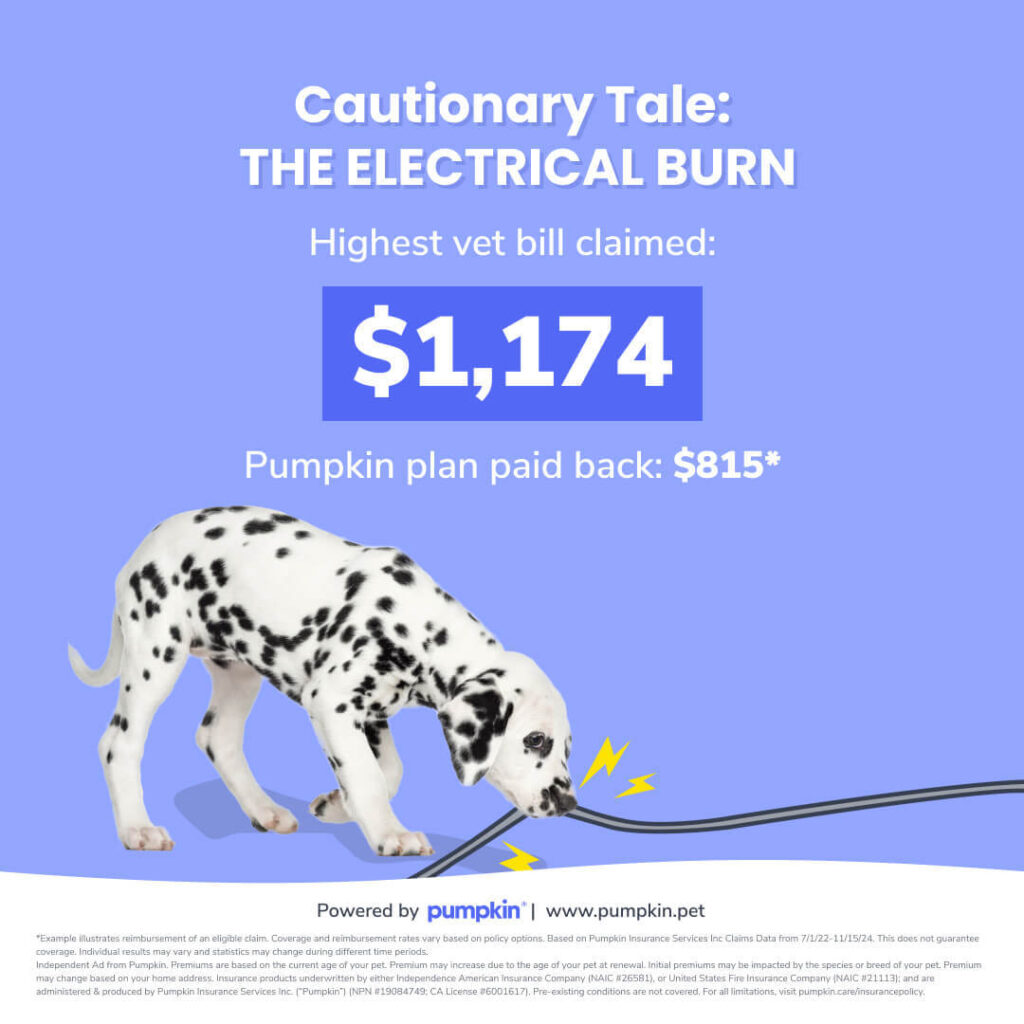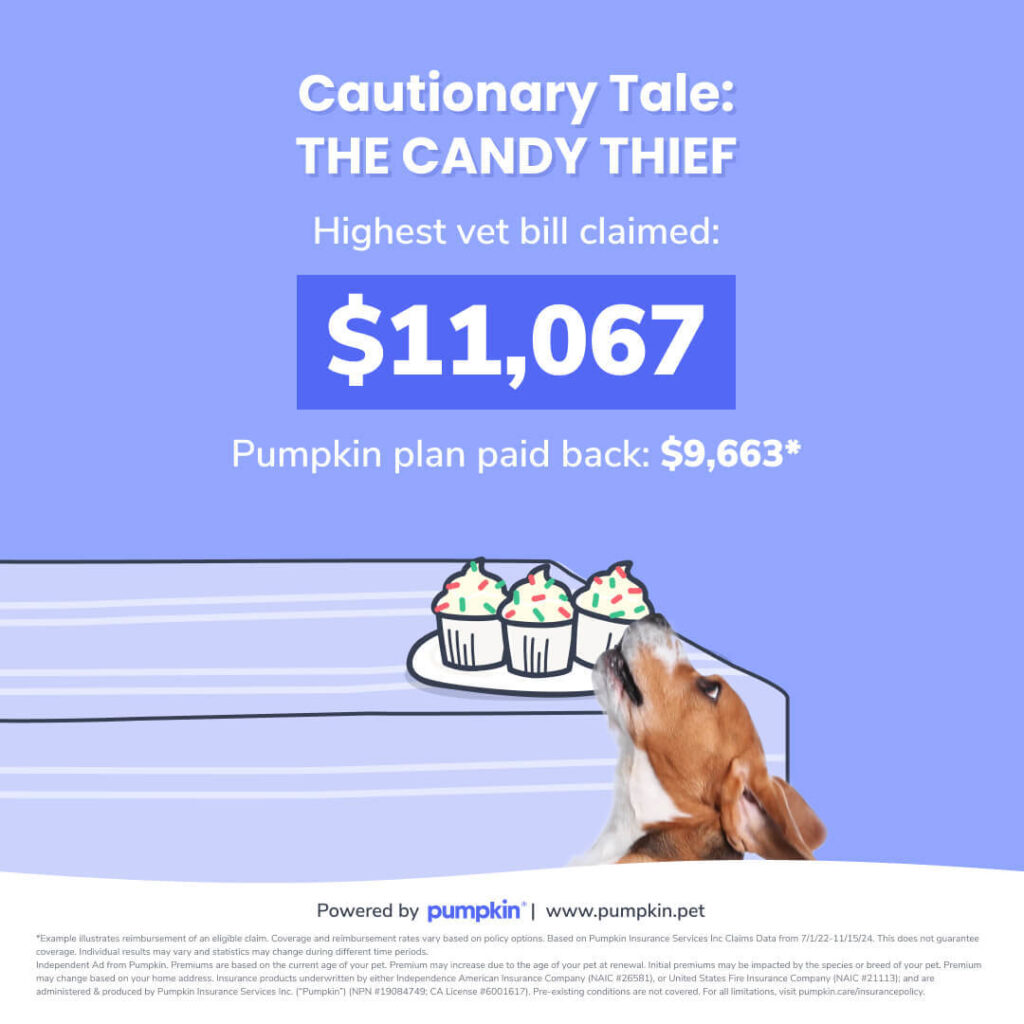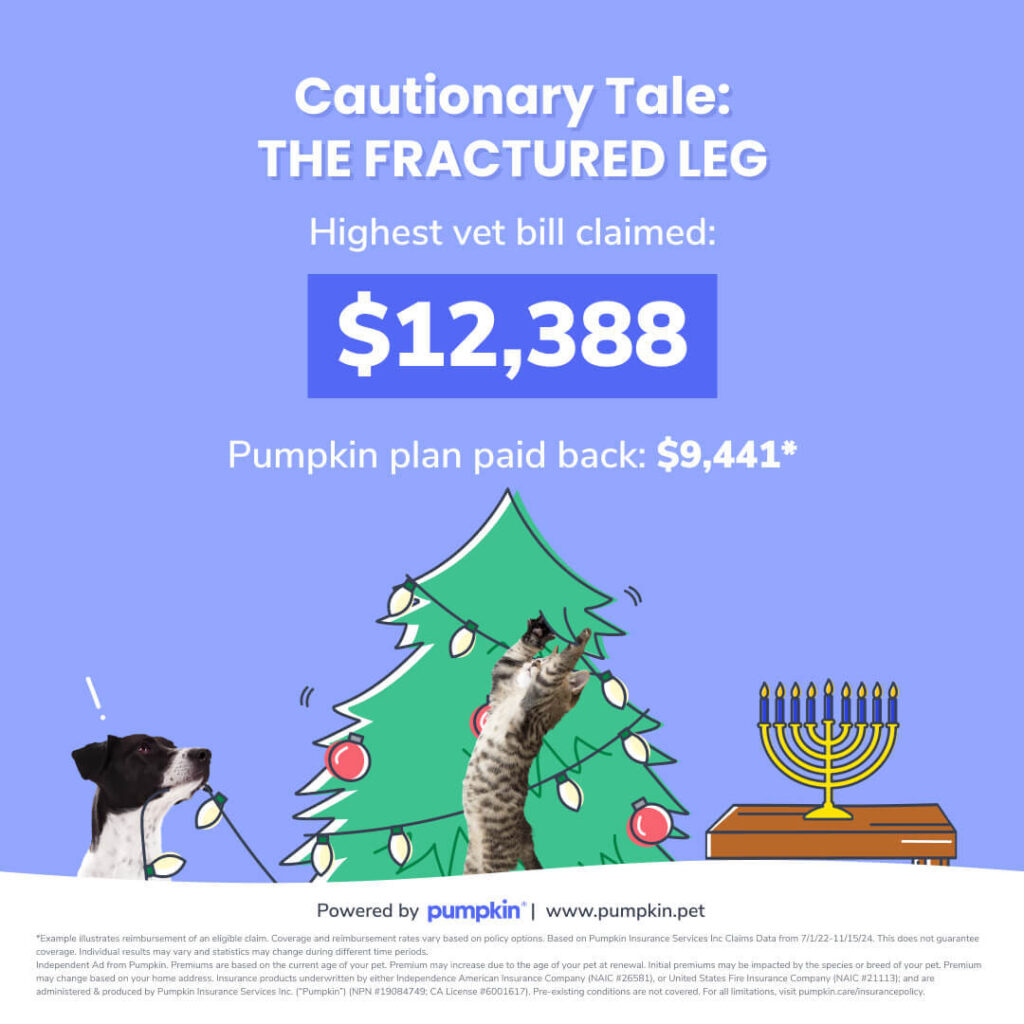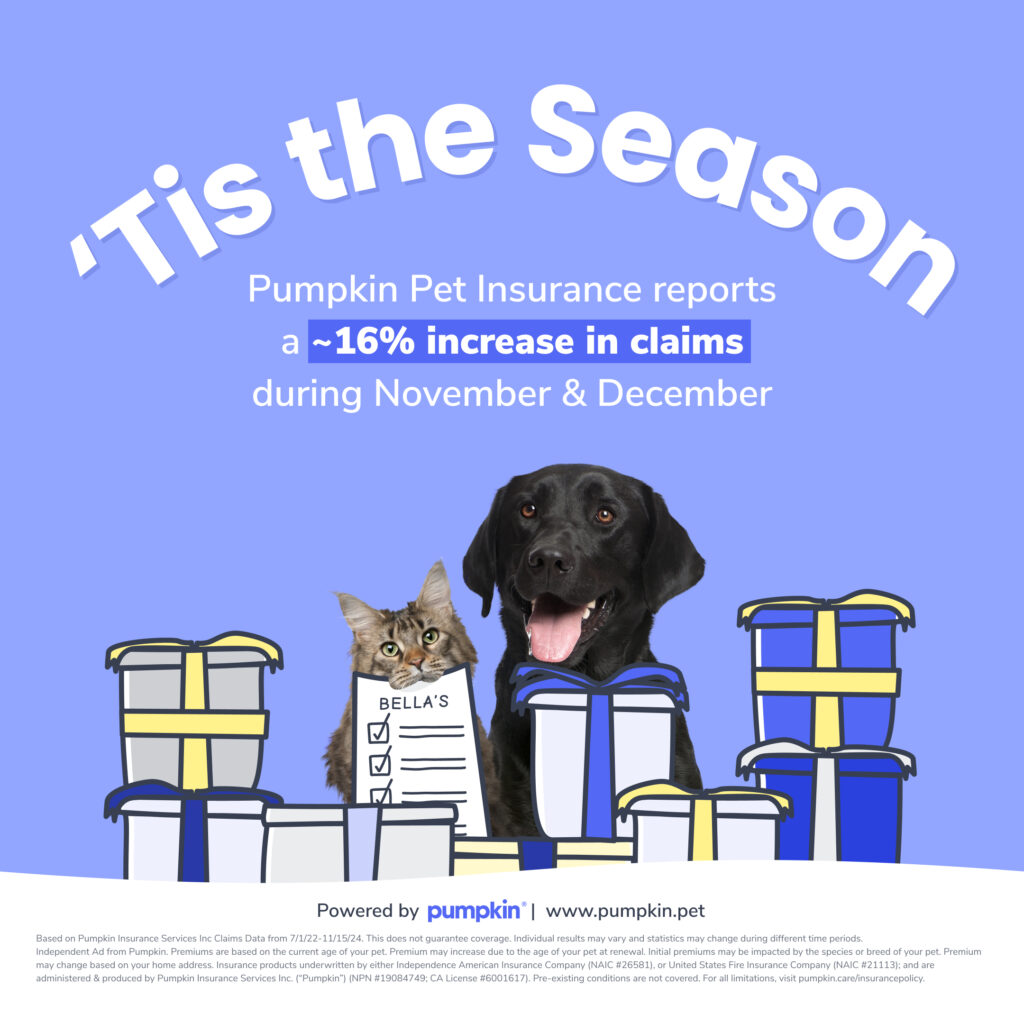- Pumpkin Team
- Nov 24
- 8 min read
Key Points
Celebrating the winter holidays with pets is more fun for everyone, but also requires a bit of extra caution.
During the holiday season, your pet may have a higher risk of eating something they shouldn’t, injuring themselves, or acting unusual — so you should consider getting pet insurance ahead of the holidays.
Pet insurance claims increased by about 16% during November and December of 2023, according to Pumpkin claims data.²
The holidays are a time for celebrating with loved ones, and of course that includes your four-legged family members. But amidst the festive cheer and family gatherings, it’s important to remember that winter can bring some unexpected dangers for pets.
Here at Pumpkin, we analyzed pet insurance claims data to identify the top issues pet parents faced last winter. We found that pet insurance claims spiked by about 16% overall in the last two months of 2023, with swallowed foreign bodies, toxic ingestions, and broken legs among the most expensive claims.
Before you say “bah-humbug,” know that it’s possible to safely celebrate the holidays with your pets — and that pet insurance can help give you some peace of mind if an accident or illness happens this winter. Unexpected vet bills can be stressful at any time, especially during the holiday season, so consider investing in a pet insurance plan before the holidays are in full swing to prepare in case your pet gets sick or hurt.
Pet Pro Tip: Pumpkin plans offer all pet parents the option of up to 90% cash back on eligible vet bills, so you can help get your pet the best possible care if they get sick or hurt — and you won’t have to skip your holiday shopping to afford it.
From tinsel garlands and lit candles to chilly paws and antifreeze puddles, let’s explore some of the most common winter pet emergencies and how to prevent them.
Watch out for electrical cords and open flames
The holiday season wouldn't be the same without festive lighting, whether your family hangs Christmas lights as soon as the weather gets cold or lights a menorah for eight nights of Hanukkah. However, power cords and lit candles both pose a risk to curious pets.
If you celebrate Hanukkah and have a countertop-surfing cat at home, you’ve probably imagined what could go wrong. Pets, particularly cats and dogs with long fur, are at risk of burns from lit candles, as well as electrical cords and hot surfaces.
Burns from stoves, heaters, and candles
When the weather gets chilly, it’s only natural to crank up the heat or make a big pot of soup — just make sure to keep an eye on your pet around the stove or fireplace.
Cats are especially prone to burning their paws on stoves or knocking over candles, while dogs might get too close to a hot fireplace or warm space heater. If your pet suffers a thermal burn, it’s important to assess the injury immediately.
What to do if your dog or cat gets a thermal burn: Rinse the burn with cool water (never ice-cold) to reduce pain and swelling. Apply a pet-safe burn ointment, and seek veterinary attention, especially if the burn is severe or covers a large area of the skin.
Burns from live electrical cords

As you’re decorating the Christmas tree this year, you might be tempted to adorn it with string lights (after all, we just cautioned you about tinsel). Just keep an extra-close eye on your pets when those lights are plugged in, as live electrical cords pose a serious hazard.
Pets can experience electrical burns from chewing on live wires or cords, which are more abundant during the holiday season. Compared to a burn from a hot surface, the shock of an electrical burn can cause more internal damage to the heart, lungs, and surrounding area (usually the mouth).
What to do if your dog or cat gets an electrical burn: For all of these reasons, you should take your pet to a nearby animal hospital immediately if they suffer electrical burns. To prevent electrical burns, try investing in an anti-chew cord protector and don’t leave cords plugged in when your pets are unsupervised.
Pumpkin’s most expensive electrical burn insurance claim: $1,174¹
Frostbite and hypothermia
Although burns are a common indoor injury around the holidays, cold weather outside can also cause harm. Dogs and cats that are exposed to extreme cold for too long may develop frostbite (a type of burn) or hypothermia.
If you’re planning to take your pet outdoors, limit their exposure to the cold, especially on icy sidewalks and snowy ground. Snow and ice can cause painful injuries like paw pad burns and frostbite if your pet isn't protected.
Keep decorations and candy out of paw’s reach
The winter holiday season is filled with tempting treats, crinkly decorations, and other exciting new items in your home. Unfortunately, many of these are harmful to pets. Chocolate, candy, and other sweet treats are commonly ingested by pets during the holidays, and even a small amount can lead to serious health issues.
Chocolate and candy toxicity

Chocolate is a well-known hazard for both dogs and cats. It contains theobromine, a stimulant that can cause vomiting, diarrhea, increased heart rate, seizures, and even death in severe cases. The darker the chocolate, the more dangerous it is, as it contains higher levels of theobromine.
If you suspect your pet has ingested chocolate, it's important to act quickly. For dogs, common symptoms include vomiting, diarrhea, restlessness, and rapid breathing.
If your dog ate chocolate but is acting fine, monitor them closely and consult your vet to determine whether treatment is needed. For cats, it can still be toxic if ingested, so keep an eye on your holiday treats.
Pumpkin’s most expensive chocolate/candy insurance claim: $11,067¹
What to do if your dog ate chocolate: If your dog eats chocolate, contact your veterinarian immediately for guidance. Do not attempt to make them throw up yourself before speaking to your veterinarian. In some cases, they may induce vomiting or give your pet activated charcoal to prevent further absorption of toxins. The sooner you act, the better the outcome.
Foreign body ingestion
Pets (especially dogs) are notorious for swallowing items they shouldn’t, from socks and chicken bones to hair elastics and shoe laces. Your glittery tinsel, gift wrap, and plastic toys could join the list if you aren’t careful.
These foreign bodies can get stuck in your pet's digestive system and cause blockages, leading to symptoms like vomiting, loss of appetite, and abdominal pain. In severe cases, surgery may be needed to remove the object from the esophagus or intestines.
Pumpkin’s most expensive foreign body ingestion insurance claim: $25,018¹ (intestinal foreign object removal)
What to do if your cat or dog swallowed a foreign body: If you suspect your pet has swallowed a foreign object, it’s crucial to seek veterinary care immediately. Depending on the size and location of the object, your vet may recommend inducing vomiting or taking an X-ray to determine the best course of action.
A note on cat ingestion hazards: Cats are also prone to swallowing items they find around the house, such as string or ribbon, rubber bands, and even parts of toys. This can lead to gastrointestinal (GI) distress and in some cases, intestinal perforation. If your cat eats something unusual, keep an eye out for signs of discomfort like vomiting or lethargy.
Beware of antifreeze puddles and icy walks
So you’ve purchased a stylish dog coat and some booties to protect your pup’s paws, and you’re ready for a wintery walk with the whole family. What could go wrong?
While outfitting your pet in winter wear is a great start, there are a couple of hazards that you’ll need to avoid on your walk: namely, antifreeze puddles and sheets of ice.
Antifreeze toxicity in dogs
Antifreeze is one of the most common causes of poisoning in pets during the winter months. This brightly colored liquid is used to regulate a car’s engine during extreme temperatures, and sometimes, it leaks.
Even small amounts of antifreeze can be fatal for both dogs or cats, although dogs are more commonly exposed. Oddly enough, the toxic chemical has a sweet taste that can attract your pet to the telltale green puddles. Symptoms of antifreeze poisoning include lethargy, vomiting, drooling, and incoordination.
To prevent antifreeze poisoning, keep antifreeze containers tightly sealed and store them in areas your pets can’t access. Clean up any spills immediately, and be especially cautious if you’re traveling with your pet in the winter, as antifreeze is commonly found on roadsides after car accidents.
What to do if your dog ingests antifreeze: If you suspect your pet has ingested antifreeze, seek emergency veterinary care immediately. Your vet may induce vomiting or administer activated charcoal to prevent the antifreeze from being absorbed. In severe cases, treatments like intravenous fluids or even dialysis may be required to save your pet's life.
Pumpkin’s most expensive antifreeze toxicity insurance claim: $680¹
Broken legs and fractures

Winter weather can make outdoor walks treacherous for both pets and their owners. Icy sidewalks and frozen ground increase the risk of slips, trips, and falls, which can lead to broken legs or fractures in pets and humans alike.
If your pet is limping, refuses to put weight on a limb, or shows signs of swelling or pain, they may have a broken leg.
What to do if your dog or cat has a broken leg: If you suspect your dog or cat has broken a bone, it’s important to get them to a veterinarian immediately for x-rays and treatment.
Depending on the severity of the injury, your pet may require surgery, splints, or casts to heal properly.
Pumpkin’s most expensive broken leg insurance claim: $12,388¹
Fractures in pets can be costly to treat. On average, treating a broken leg in a dog costs around $1,000, while treatment for a broken leg in a cat is slightly less expensive. However, more serious fractures can run into the thousands of dollars, making it even more important to consider pet insurance for peace of mind during the winter months.
A notes on salty paws
When you’re out taking your dog on a walk, you might notice bits of salt on the road or sidewalk. The rock salt used in ice melts can make your dog sick if they eat a lot of it, and, more commonly, can irritate your pup’s paw pads.
Make sure to wipe off your dog’s paws with a damp cloth after walks to avoid dryness, cracking, and even burns from prolonged exposure to salt. Ice and snow can also irritate dogs’ paws, so you may want to consider using booties on long walks for added protection.
Final thoughts: Plan ahead for your pet’s health

As you celebrate the winter holidays, remember that your pet’s health and safety should always come first. From avoiding toxic foods to taking precautions against burns and fractures, there are many ways to protect your furry companions during this festive time of year.
Make sure to keep hazardous items out of reach, watch for signs of illness or injury, and consult your vet if you have any concerns. Pet insurance can also be a valuable tool to help cover unexpected medical costs, especially as claims tend to increase during the holidays, so get a free quote from Pumpkin today.
Now that you know some of the most common things that can go wrong with your pet this holiday season, go pour yourself a mug of eggnog and hang that tinsel higher than a cat can jump. And don’t forget to give your pet some extra love amidst all the holiday hubbub!
¹Based on Pumpkin Insurance Services Inc claims data from 7/1/2022 – 11/15/2024.
²Based on Pumpkin Insurance Services Inc claims data from 1//1/23 – 12/31/23.

